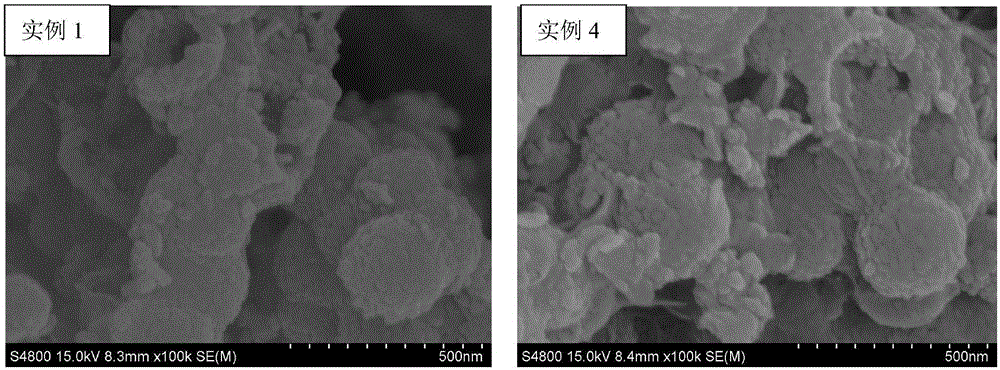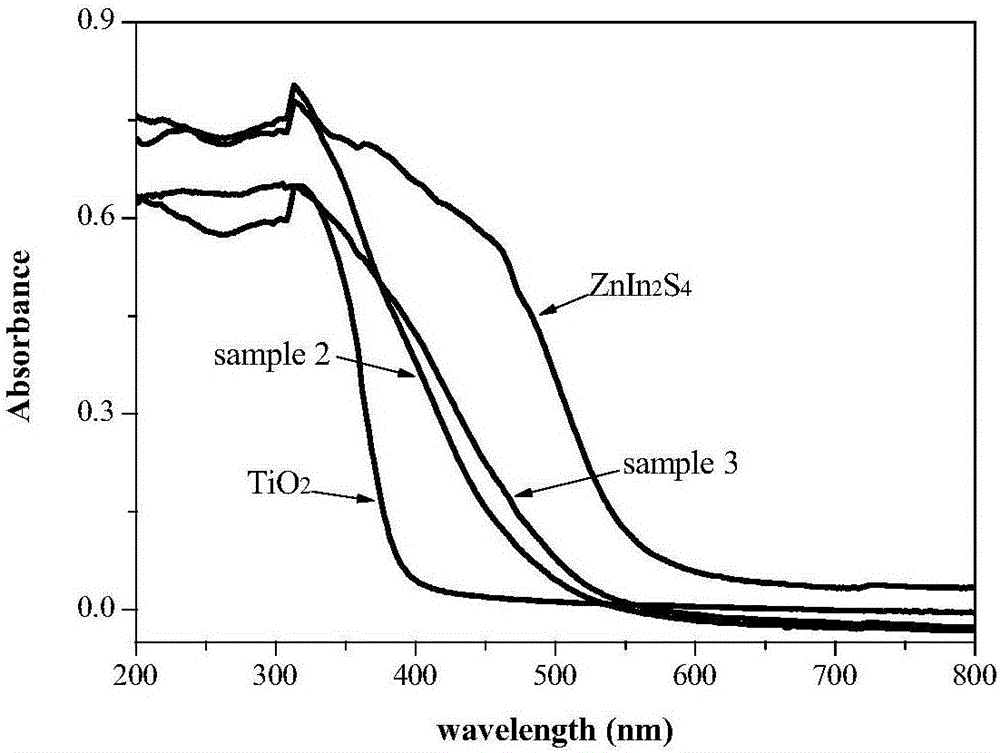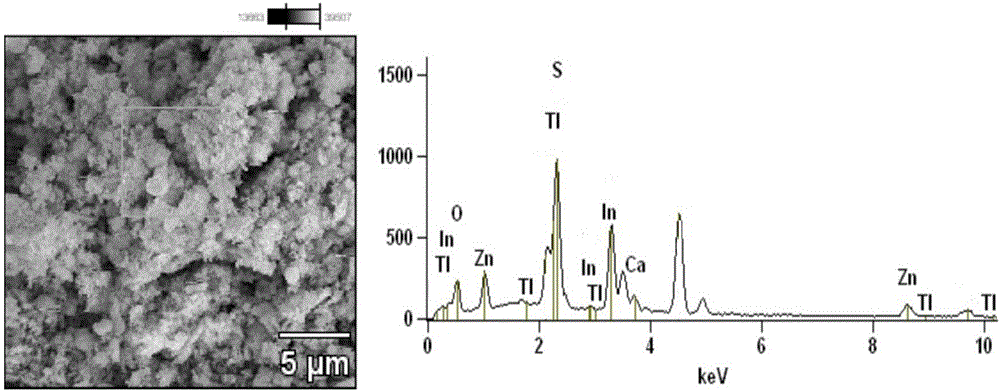Preparation method and application of compound photocatalyst for growth of ZnIn2S4 on surfaces of TiO2 hollow spheres
A surface growth, hollow sphere technology, applied in physical/chemical process catalysts, chemical instruments and methods, water/sludge/sewage treatment, etc., can solve problems such as no reports, and achieve convenient operation, mild reaction conditions, and energy consumption. less effect
- Summary
- Abstract
- Description
- Claims
- Application Information
AI Technical Summary
Problems solved by technology
Method used
Image
Examples
example 1
[0027] (1) Weigh 0.05g TiO 2 Hollow sphere, TiO 2 The diameter of the hollow sphere is 200-400nm. Measure 20mL of twice distilled water in a beaker, sonicate for 10min, and then stir for 2h to obtain TiO 2 Hollow sphere dispersion.
[0028] (2) Weigh 0.052g zinc nitrate, 0.115g indium nitrate, 0.069g thioacetamide (TAA) and 0.045g cetyltrimethylammonium bromide (CTAB) in sequence and add them to step (1) to prepare TiO 2 hollow sphere dispersion; then the suspension was stirred for 2 hours; then the suspension was transferred to a reaction kettle for reaction; the reaction temperature was 160°C, and the reaction time was 6 hours. After the reaction, after cooling to room temperature, the obtained product was washed several times with deionized water and absolute ethanol, and dried in vacuum to obtain TiO 2 Growth of ZnIn on the surface of hollow spheres 2 S 4 Composite photocatalyst, where ZnIn 2 S 4 The content of the composite photocatalyst is 45.8%.
[0029] With ...
example 2
[0032] (1) Weigh 0.1g TiO 2 Hollow sphere, TiO 2 The diameter of the hollow sphere is 200-400nm. Measure 30mL of twice distilled water in a beaker, sonicate for 5min, and then stir for 2h to obtain TiO 2 Hollow sphere dispersion.
[0033] (2) Weigh successively 0.103g of zinc nitrate, 0.224g of indium nitrate, 0.135g of thioacetamide (TAA) and 0.090g of cetyltrimethylammonium bromide (CTAB) into step (1) to obtain TiO 2 hollow sphere dispersion; then the suspension was stirred for 2 hours; then the suspension was transferred to a reaction kettle for reaction; the reaction temperature was 160°C, and the reaction time was 7 hours. After the reaction, after cooling to room temperature, the obtained product was washed several times with deionized water and absolute ethanol, and dried in vacuum to obtain TiO 2 Growth of ZnIn on the surface of hollow spheres 2 S 4 Composite photocatalyst, where ZnIn 2 S 4 The content of the composite photocatalyst is 55.9%.
[0034] The ph...
example 3
[0037] (1) Weigh 0.30g TiO 2 Hollow sphere, TiO 2 The diameter of the hollow sphere is 200-400nm. Measure 80mL of twice distilled water in a beaker, sonicate for 15min, and then stir for 3h to obtain TiO 2 Hollow sphere dispersion.
[0038] (2) Sequentially weigh 0.034g zinc nitrate, 0.076g indium nitrate, 0.045g thioacetamide (TAA) and 0.030g cetyltrimethylammonium bromide (CTAB) and add them to step (1) to prepare TiO 2 hollow sphere dispersion; then the suspension was stirred for 2 hours; then the suspension was transferred to a reaction kettle for reaction; the reaction temperature was 180°C, and the reaction time was 8 hours. After the reaction, after cooling to room temperature, the obtained product was washed several times with deionized water and absolute ethanol, and dried in vacuum to obtain TiO 2 Growth of ZnIn on the surface of hollow spheres 2 S 4 Composite photocatalyst, where ZnIn 2 S 4 The content of the composite photocatalyst is 12.4%.
[0039] Visi...
PUM
| Property | Measurement | Unit |
|---|---|---|
| band gap | aaaaa | aaaaa |
| diameter | aaaaa | aaaaa |
Abstract
Description
Claims
Application Information
 Login to View More
Login to View More - R&D
- Intellectual Property
- Life Sciences
- Materials
- Tech Scout
- Unparalleled Data Quality
- Higher Quality Content
- 60% Fewer Hallucinations
Browse by: Latest US Patents, China's latest patents, Technical Efficacy Thesaurus, Application Domain, Technology Topic, Popular Technical Reports.
© 2025 PatSnap. All rights reserved.Legal|Privacy policy|Modern Slavery Act Transparency Statement|Sitemap|About US| Contact US: help@patsnap.com



